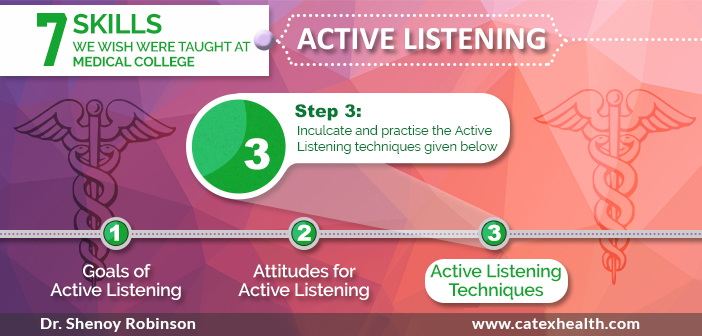In the last article, we discussed 4 key attitudes conducive to Active Listening. In this article, we explore some techniques that will help us practice and inculcate this skill in our day-to-day practice.
Let us begin with an example:
I am the Casualty Medical Officer (Emergency Room doctor), and a patient that has been involved in a fight is brought in. I examine the patient and find that there are a few superficial cuts and bruises on his face, and no other injury. The patient insists that the hospital file a complaint with the police. I immediately tell the patient that as he does not have any major injury, he should go to the police station on his own and file the complaint there himself. I also add that doctors are busy professionals and our primary job is to look after patients and not file police complaints and reports.
How do you think the patient and his relatives will react? Do you think the situation better could have been handled better?
We’ll come back to this story later.
4 Active Listening techniques
Most books and writers on the subject outline ten to twelve techniques of active listening, but I have chosen to focus on four, as I believe these are the most important and effective. The following aspects emphasise how we must act on the information we have gathered during and after listening to patients, because as we discussed, active listening is going one step further and effectively processing the input we have received.
Technique 1: Attending
This technique deals largely with our body language, the essence being to non-verbally convey to patients that we care and are very interested in what they have to say.
The key is to stop all activity and give our full, undivided attention to the patient. Face the patient and look at them while they speak, which not only assures them that we are listening to them but also provides us non-verbal cues regarding the core message and feelings that we are trying to discern.
To summarise, attending requires the following:
1. Momentarily suspending all activity
2. Keeping body language open and facing the patient
3. Encouraging through nodding and reassuring words
It is important to refrain from engaging in other actions, like attending a phone call or looking at our mobile and computer screens, as these convey that we are not paying complete attention.
It is also effective to encourage them with short, verbal comments like “yes”, “Ok”, “aha”, etc., which reassure them that we are fully engaged with them and their problems.
This may look very simplistic and easy, which it is, but a lot of us do not put it into practice.
Technique 2: Paraphrasing
Paraphrasing involves repeating in our own words what we have understood from what the patient has been describing. We must be careful to try and use different words from the ones the patient had or it may seem we are simply parroting but not really internalizing the information.
Paraphrasing ensures that there is no gap in what the patient is trying to say and what has been understood by us, thereby reducing the chance of misunderstandings.
It also powerfully reassures the patient that the healthcare professional attending to them is completely clear about their problems and issues.
It is important to not add any of our own assumptions during paraphrasing and also not appear to be judgmental
Paraphrasing saves a lot of time in the long run because once the patient is assured that they have been understood, they will not feel the need to repeat the same things.
Technique 3: Clarifying
Clarifying is the next technique, which is self-explanatory, wherein we ask questions to enhance our understanding. There are three things that we should be appreciative of while using this technique:
1. Ask open-ended questions
These are not simple yes or no questions. We want the patient to talk and describe the issue, and these could be framed as “Ok, please take your time and tell me”, “How did this happen?” or “What do you think caused this?”, so on and so forth. Our objective is to get them to talk as much as possible so that they feel that they have been given an adequate opportunity to unload.
2. Don’t ask questions that put them on the defensive
It is important for patients to feel that they have done nothing wrong and therefore, intimidating questions put them on the defensive. This may then cause them to withhold information or choose not to disclose important information, especially on the past treatment that they may have undergone before approaching us. This can have important repercussions while diagnosing or treating them .e.g., “Why?” is intimidating. Don’t ask “Why?” Rather, use “How come?”
3. Ask about their feelings
“How do you feel?” is an important query, as patients love to have their feelings heard and validated.
Technique 4: Summarising
We must attempt to end our conversations with a summary of what we have understood about their main concerns, issues, complaints and equally importantly, their feelings.
The heart of summarising lies in accurately identifying their core message and core feelings, and having the patient validate this summary.
Why do our patients feel that they have not been listened to?
- We don’t give them adequate time to relate their story completely.
- We interrupt them when they are speaking.
- We are busy on our laptops or mobiles when they are sharing.
- We frame questions regarding how they are feeling but focus on facts and not their feelings.
- We do not paraphrase or summarise.
- We ask intimidating questions and are judgmental, causing them to be reticent.
I believe that most of us doctors practice these techniques in our own ways, having learnt them over time from sheer experience, but we do wish they had been taught to us in a formal, structured manner during our training in medical college, which could have tapped into our potential much sooner and left space for more discoveries.
We now come back to the story of the ER patient. In the light of what we discussed, the situation could have been handled a lot better. By telling the patient that he was okay and not injured,the ER doctor did not listen to him and disregarded his feelings and those of his relatives. The doctor focused on facts and not on the patient.
The manner in which we convey bad news to the patient’s relatives regarding prognosis can be done better if we are aware of the high levels of anxiety, fear and anger.
Next week, we will be discussing the second differentiating competency “Empathy”.





Interesting
Thank You
Dear , this is turning out to be a nice series. Can all this be collected at ONE place at the end of it all ; will be very useful skill enhancing tool for any medical practitioner as well as institution . Thanks sir
Thank you Dr. Parashar, we hope to convert these into a handbook later. after adding all the inputs from our readers
For these listening skills to be effective you need to do all of them not just one or two. Often, we tried to slide by with just doing one of them. But listeners are attuned to our disengagement when we don’t do all for of Dr. Shenoy’s suggested steps. Oh, and doing them in the order presented works to your advantage.
You hit the nail on the head Andrew, Thanks for sharing.
It s very helpful for upcoming young doctors sir
Thank you Dr. Shiva.
I am really looking forward to next week’s piece on Empathy. I just left (literally a couple of hours ago) the bedside of a friend who was diagnosed with colon cancer. I was stunned as I listened to his physician present the facts to him. While completely detailed in providing the facts, I saw no the physician sharing no compassion or empathy in the process. If I was stunned by the apparent lack of “sensitivity”, I can only imagine (and actually know because we talked about it later) how my friend felt. I am sure the physician has delivered this message so many times it is mechanical, it wasn’t personal. But, for my friend hearing it for the first time, it was very personal. Ed
Dear Ed, thank you for sharing. With your more than 30 + years of experience in the health care industry you have probably seen it all, yet when you used the words “stunned” we can imagine how far we have to travel or conversely how far we have traveled from. My best wishes for your friends recovery.